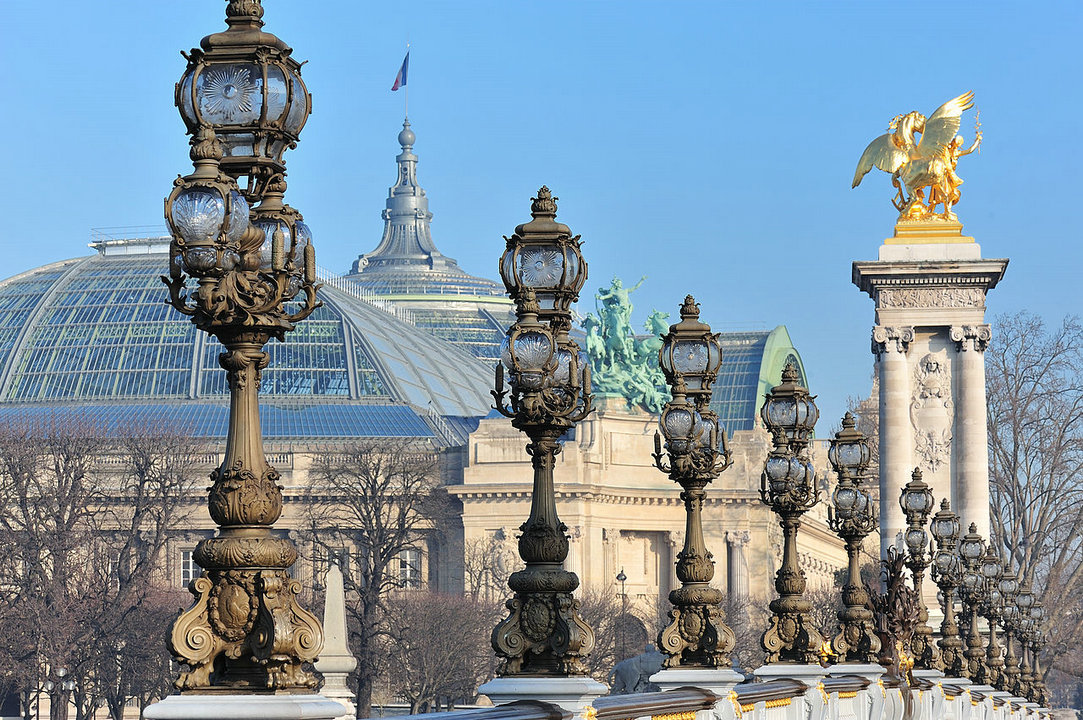The Grand Palais des Champs-Élysées, commonly known as the Grand Palais (English: Great Palace), is a large historic site, exhibition hall and museum complex located at the Champs-Élysées in the 8th arrondissement of Paris, France. Construction of the Grand Palais began in 1897 following the demolition of the Palais de l’Industrie (Palace of Industry) as part of the preparation works for the Universal Exposition of 1900, which also included the creation of the adjacent Petit Palais and Pont Alexandre III.
What do Guillaume Apollinaire, Karl Lagerfeld, Prince and Thomas Dutronc have in common? Answer – they are all great admirers of the Grand Palais’ architecture. Built for the Universal Exhibition in 1900, it was classified as a historic monument in 2000. Situated in the very heart of Paris on the Avenue des Champs-Élysées, it is particularly famous for its glass roof, the largest in Europe.
The structure was built in the style of Beaux-Arts architecture as taught by the École des Beaux-Arts of Paris. The building reflects the movement’s taste for ornate decoration through its stone facades, the formality of its floor planning and the use of techniques that were innovative at the time, such as its glass vault, its structure made of iron and light steel framing, and its use of reinforced concrete.
Because we believe in culture in the broadest sense of the term, our programme is a mixture of fine arts, fashion, photography, music, dance, cinema, theatre, and even sport. In the past year we have collaborated with the Met, Museo Thyssen-Bornemisza, FIAC, Paris Photo, Red Bull, Ludéric Evènement, Chanel, Radio FG, and MK2, among others. In short, the Grand Palais responds to its 2 million visitors each year in all their diversity and different needs.
One of its pediments calls it a “monument dedicated by the Republic to the glory of French art”, reflecting its original purpose, that of housing the great artistic events of the city of Paris. The competition to choose the architect was fierce and controversial, and ultimately resulted in the contract being awarded to a group of four architects, Henri Deglane, Albert Louvet, Albert Thomas and Charles Girault, each with a separate area of responsibility.
The main space, almost 240 metres long, was constructed with an iron, steel and glass barrel-vaulted roof, making it the last of the large transparent structures inspired by London’s Crystal Palace that were necessary for large gatherings of people before the age of electricity. The main space was originally connected to the other parts of the palace along an east-west axis by a grand staircase in a style combining Classical and Art Nouveau, but the interior layout has since been somewhat modified.
The exterior of this massive palace combines an imposing Classical stone façade with a riot of Art Nouveau ironwork, and a number of allegorical statue groups including work by sculptors Paul Gasq, Camille Lefèvre, Alfred Boucher, Alphonse-Amédée Cordonnier and Raoul Verlet. A monumental bronze quadriga by Georges Récipon tops each wing of the main façade. The one on the Champs-Élysées side depicts Immortality prevailing over Time, the one on the Seine side Harmony triumphing over Discord.
The Grand Palais has a major police station in the basement whose officers help protect the exhibits on show in the Galeries nationales du Grand Palais, particularly the picture exhibition “salons”: the Salon de la Société Nationale des Beaux Arts, Salon d’Automne, and Salon Comparaisons. The building’s west wing also contains a science museum, the Palais de la Découverte.
It was the host venue of the 2010 World Fencing Championships.
For the 2011 Monumenta exhibition (11 May to 23 June), sculptor Anish Kapoor was commissioned to create the temporary indoor site-specific installation, Leviathan, an enormous (ca. 775,000 square feet) structure that filled half of the main exhibition hall of the Grand Palais.
